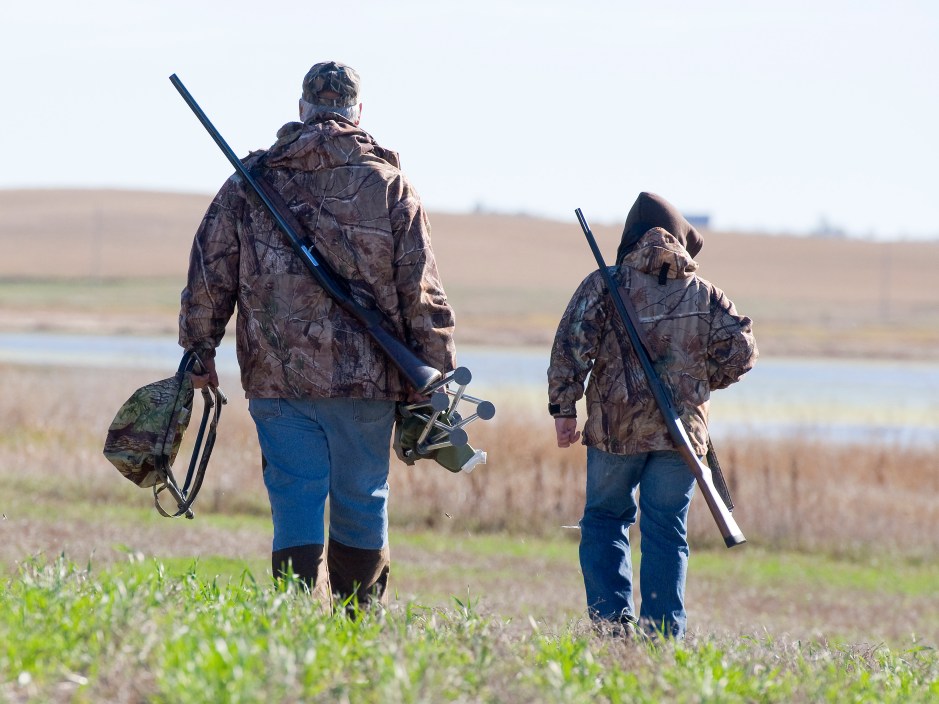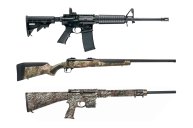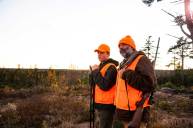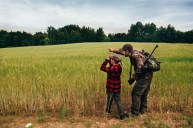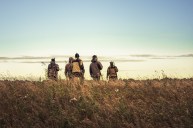Every year, hunting accidents serve as stark reminders of how important it is for hunters never to become complacent. From hunters falling out of their treestands to tragic misfires to wader-related drownings, the list goes on.
But preventing avoidable accidents, such as child hunters mishandling their weapons, begins with instilling a safety mindset that youth hunters will carry with them for a lifetime. However, "for a lifetime" is the challenging part. According to the New York State Department of Environmental Conservation, nearly 14% of the state's hunting accidents in 2020 were caused by hunters with at least a decade of experience. What's worse, the offending hunters had reported taking hunter education at some point in time. (Just not recently enough, obviously.)
So, what's it going to take to teach kids to hunt with care, but also keep them safety-minded into adulthood? We talked to two kids' hunting safety experts to learn more.
1. Live By the Four Rules of Firearm Safety
When it comes to youth hunter safety advice, there's no better place to start than with gun safety. It's a subject that's top of mind for Willard Franklin III, a safety expert and CEO of Four W's Outdoor. The longtime industrial safety professional and youth hunting mentor stresses the importance of following the four universal gun safety rules.
Treat Every Firearm as if it's Loaded
By treating every firearm as if it is loaded, you are more likely to practice safe handling techniques consistently. This mindset helps prevent accidental discharges, which often occur under the assumption that a firearm is unloaded. It's a safeguard against complacency, ensuring that no matter the situation, the firearm is handled with the utmost caution.
Practice Muzzle Control
Or never aim the muzzle at anything you are not willing to destroy. This rule underscores the lethal potential of a firearm. Shooters need to be constantly aware of the firearm's direction and to consciously direct it away from people, animals, or any valuable property. Muzzle control is vital in all situations, whether at the range, cleaning the gun, or transporting it. Always remember the destructive power at your fingertips and the importance of controlling it.
Keep Finger Off the Trigger Until Ready to Fire
This means the finger stays off and away from the trigger until you are ready to fire. Doing so reduces the risk of accidental discharge. Accidents often occur when people are startled or lose their balance, causing an involuntary trigger pull. By keeping your finger outside the trigger guard until you are ready to fire, you significantly reduce the risk of unintentional shooting.
Be Sure of Your Target and What is Beyond It
This rule involves not only identifying your target with certainty but also being aware of the surrounding area. Bullets can over-penetrate or miss the intended target, posing a risk to others in the vicinity. It's crucial to consider what lies beyond the target, whether it's shooting at a range, hunting, or in a self-defense scenario. You're responsible for every bullet that comes out of your gun.
2. Take Hunter's Ed—And Practice What They Preach
Beyond hunter education, Franklin—a big waterfowller—recommends digging deep into hands-on firearms safety training and practicing with kids.
"Everything you do has to begin with gun safety," Franklin told Wide Open Spaces. "You have to practice it and live it—you can't just talk about it. In Texas, we do hunters ed. We watch videos, then we go to the gun range and shoot maybe four times and then they call that done. That's crazy to me."
In other words, just taking a six-hour hunter safety course is not the same as standing, shooting, and moving. "You have to send 30, 40, 50 rounds downrange before you're even comfortable with that shotgun," he says. "Same goes for rifles, pistols, and crossbows. You take a shot and the gun goes back on safety, then on the table. It's all about repetition under instruction, and in different situations like sitting in a boat."
The youth hunting mentor also suggests having a pre-hunt "safety briefing." Have gun safety conversations with your young hunter on the way to the site. Discuss everything from shooting position and tactics of the hunt to how you'll get to and from the blind safely with a weapon. Have the hunter repeat it back to you.
Laying out the plan in this way will reinforce caution and help ensure that youth hunters don't forget those key points when handling firearms.
3. Learn Orienteering Skills to Navigate the Backcountry
As a foundational backcountry skill, knowing how to navigate remote landscapes is necessary for every budding hunter. Getting where you're going is one reason. Not ending up lost and hypothermic 5 miles in the backcountry is another. Orienteering with a map and compass is key to both.
Tom Ryle of Washington Department of Fish and Wildlife (WDFW) is a longtime hunter and a dad who knows a thing or two about teaching. He should: Ryle's team creates the safety and instructional content for the Washington Department of Fish and Wildlife. One skill set he suggests drilling into kid hunters is the fundamentals of navigation.
"Basic field map and compass navigation may seem too complicated for youth hunters," Ryle says. "But reviewing maps and talking about bearings and road systems in relation to where you'll be hunting establishes an important foundation for staying found."
Teach kids how to read a topographic map, then instruct them how to take a field bearing and plot it on a map. Next, do the opposite and teach them to estimate their position by triangulation using landscape features (water bodies, peaks, etc.) on the map. Take a bearing off the topo and practice navigating to it in a familiar environment before taking it to the mountains. With this skill, if they're lost with a dead cell phone or GPS unit, they'll have a good chance of finding their way out.
Once youth hunters have the basics down, Ryle says kids can then migrate to useful tools such as onXmaps, which will make more sense if they start with analog tools and gain the basics first.
4. Practice Safely Moving Through Terrain
When two Kentucky hunters left for their respective hunts in November of last year, the last thing either expected was to fatally shoot themselves after they slipped while walking. But that's exactly what happened when both 77-year-old Russell Stillwell and 26-year-old Benjamin Brogle, Jr. died in separate accidents a day apart from each other.
These two tragedies underscore the importance of teaching kids how to move through different terrain types safely while carrying weapons, something Franklin takes great care in while teaching his students. "When I'm taking kids with shotguns to the duck blind, the guns stay in the gun case, that's number one—and they're unloaded," Franklin says. "You don't want them carrying a loaded shotgun, trying to maneuver in 2 feet of water and muck—they're gonna trip and they're going to fall in the water. If they're carrying a shotgun, the first thing they're gonna do is pull the trigger," he says.
Franklin says teaching kids to keep guns unloaded and in cases until they get in position at the hunting area is a safety practice he repeats over and over. He suggests you do, too.
5. Know Ground-Blind Safety
Treestand accidents are becoming increasingly common, but hunting in an enclosed area like a ground blind also presents its own safety challenges. And if you're hunting with kids, you're going to be hunting from one sooner than later.
"Hunting with kids in pop-up ground blinds can provide many advantages for youngsters, Ryle says. "However, teaching proper muzzle control while entering, exiting, and setting up for a shot is crucial to prevent accidents, as is proper handling of broadhead tipped arrows or crossbow bolts in a confined space, especially in low-light conditions [at dusk or dawn]," he says.
Instruction should also include unloading the firearm when entering and leaving the blind. Accidents can happen either as a result of tripping while getting in the blind, or when loaded guns that are propped against a chair fall over and discharge.
Kids will also need to know about decoy placement in relation to the ground-blind setup. Teach them to consider the direction other hunters may come from, and set the blind up in a way that keeps them and other hunters out of the direct line of fire.
6. Study the Rules and Behave Responsibly
Responsible hunting behavior takes on many forms, from respecting other hunters to getting game out of the field in a timely manner. When you teach responsible behavior to youth hunters, safety follows as a natural byproduct.
For Ryle, one way of doing that is reinforcing the habit of reviewing key questions before shooting at game. He suggests getting kids in the habit of asking themselves:
- Have you reviewed the hunting regulations for the area you're hunting?
- Do you know the local laws about shooting from gravel roads?
- Do you have a safe backstop or know what's beyond your target?
- Can you positively identify your target as a legal animal?
- What are the conditions, in terms of weather and time of day? Do you have a good plan to recover your game?
Franklin wants youth hunters to know that no matter who's in their hunting party on any given occasion, if they see unsafe behavior, they can call it out, or "stop the job," as he calls it. Franklin says: "If they see someone violating the safety rules—swinging the gun over someone's head or not putting it back on safety—everybody has the authority to say something and stop that action."
7. Keep Yourself Safe While Field Dressing
One topic that's often overlooked in planning for a successful hunt, says Ryle, is safety around what to do after a kill. "So much is written about how to become successful [killing game]. But there is a substantial lack of good information about what to do after the shot," he says. "As a mentor, it's good to review available resources and discuss the details of proper field care."
Youth hunters should be taught to wear nitrile gloves to protect themselves from diseases sometimes found in the blood of animals. You may also consider wearing cut gloves underneath for additional safety while processing. They add a layer of protection in the event of a near-miss caused by a slicing motion (though they don't protect against stabbing actions).
Franklin reminds us to keep knives sharp. "The sharper the knife the easier it cuts," he says. "It's less pressure you have to put on the knife and less time you have to spend cutting. A sharp knife makes all the difference." That, as well as cutting away from yourself and keeping your fingers tucked in, chef style, reduce field-dressing injuries.
8. Mind Your Mentors
Both Ryle and Franklin see ongoing mentoring and role modeling as the key to creating safety-minded hunters who don't get complacent. It's built into the training.
"Role modeling good safety practices is one of the best ways to mentor youth hunters," says Ryle, whose father's early lessons still stick with him today. "Things like stepping over—not on—logs to ensure solid footing is something my dad taught me as a kid. I think about it to this day each time I cross over a downed tree."
Ryle also says discussing and selecting proper clothing, footwear, and helping assemble a basic hunting pack with the cord, knife, and the 10 essentials are of key importance as well.
Franklin says the biggest thing is mentoring and educating. "Make it enjoyable but always start off with a safety message," he suggests. "Whether it's eye protection or a lifejacket, if you don't use it, it won't work. It's the same with hunter safety or gun safety. If you don't practice, it's not going to work and keep something from going wrong."
